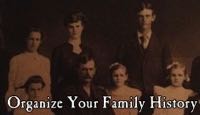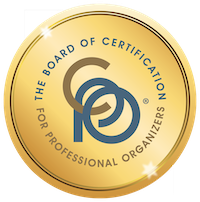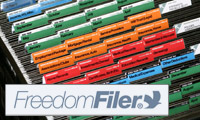Keeping the important top of mind
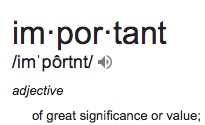
It’s so easy to focus on urgent tasks, rather than important ones, isn’t it?. Every day I create a list of tasks I want to accomplish that day. (When I’m on my game, I do it the night before.) I try to keep the list short so I have a fighting chance of actually accomplishing all of them.
That approach often results in a short list of items that are calendar-driven. Sometimes they’re important, but often they’re simply urgent. One day last week, I emptied my brain of the urgent tasks and realized none of the items were particularly important. Then, when I put my mind to it, I remembered some projects that were languishing. It was a reminder that it’s important to consider the important-but-not-urgent tasks when I’m putting together my task list.
Considering those tasks when you’re figuring out what to do next can help you be successful. When you work on important projects in bites, over time, you can take more thoughtful action, rather than always rushing to get something done. It can decrease stress. Eventually, if you’re successful at staying on top of important tasks, you’ll have fewer urgent tasks populating your to-do list. And that’s a nice way to live, in my opinion.
So how can you keep the important projects and tasks top of mind? For some people, it starts with setting goals. If you set goals, the important tasks become more obvious, because they’re in service of the goals. You can keep a list of your goals or projects in front of you (on a bulletin board, for example) or use reminders on your phone or computer to bring them top of mind. You can create a paper or electronic list of important projects and break the projects into tasks, then schedule the tasks. For many people, interim deadlines are really helpful.
There’s no one right way to do it; I encourage you to experiment with different methods.
One thing that can be very beneficial is to schedule time in your week or month to ruminate. Think about how things are going and how they might improve. If you feel like you’re on a hamster wheel, for instance, think about what you’d do if you could hop off the hamster wheel. Then think about how you could make that happen. Brainstorm with yourself using whatever tools feel right. For example, I keep track of tasks in my computer, but I like to brainstorm with pen and paper, often using mind maps.
One way I ruminate is to schedule monthly floats in a flotation tank. While I’m floating I get great insights and sometimes I remember important projects that had fallen by the wayside. I always take along my float journal so I can jot down the ideas that come to me. And periodically I review my float journal.
How do you keep track of your important projects and tasks?
Worth repeating: It's holiday card time
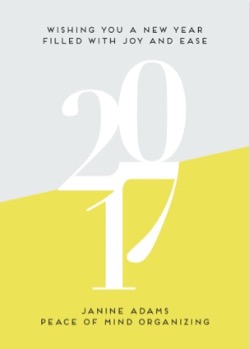
I wrote this post on October 31, 2012. It seems timely to repeat, since on Saturday I ordered the holiday cards for my business. That’s the front of this year’s card at right…I like to order New Year’s cards because they’re secular and give me the ease of an extra week to send them. I still use Minted.com (they’re awesome) and they now will (stylishly) print your recipient addresses on the envelopes at no extra charge. So that means I needed to finalize my recipient list before finalizing the card order. It feels so good to have that finished already! I’ll have plenty of time to write notes on each recipient’s card.
I’m thinking about holiday cards for my clients and colleagues and I’m whispering to myself, “Let it be easy.” In the past, I’ve tended to make holiday cards way more complicated than they need to be.
My friend, Margaret Lukens turned me on to Minted.com, which sells lovely personalized cards. Lots of different designs. So I spent some time there considering the offerings and was starting to feel overwhelmed by the options (as usual).
So I’ve boiled it down to these first tasks:
- Decide how many cards I need, even if it’s a ballpark number
- Stick with the design I’ve already chosen and customized
- Make final decisions about the last trivial options
- Submit and check out and stop worrying about it
I’m going on vacation next week (more on that later this week!) and the cards should arrive shortly after I get home. Then I’ll have time to update my list, print my address labels and enjoy the task of getting them out in a leisurely fashion.
No need to get myself tense about this. Thanks to the internet, I can create beautiful, customized cards without even leaving my desk. Now that’s easy.
How about you, have you started thinking about your holiday cards and how easy you can make them? (Hint: Not sending any is the easiest option and a perfectly viable one.)
National Prescription Drug Take-Back Day is back!

Almost everybody has old prescription drugs cluttering up their bathrooms and other spaces. The trouble is, it’s hard to dispose of them responsibly.
On Saturday, though, it’s easy. A couple of times a year, the Drug Enforcement Administration, in conjunction with the Department of Justice, sponsors the National Prescription Drug Take-Back Day, where consumers can drop off their old medications for proper disposal.
That day is this Saturday, October 22, from 10 am to 2 pm!
Click here to find a collection site near you.
The first Drug Take-Back Day took place in 2011 and it’s been a success from the outset. In the May 2016 nationwide event, they collected 893,498 pounds — about 447 tons! — of unneeded or expired medications. Those are drugs that might have landed in the landfill and damaged the environment, or perhaps in the hands of abusers or children.
This is a great opportunity to declutter your medicine cabinet!
Happy birthday to Bix!
I’m going to indulge myself today and write a post about my standard poodle puppy, Bix, who turned one yesterday. Just two weeks after he joined our family, when he was a rambunctious 10-week-old puppy, he totally disrupted my life, as is to be expected. At that time, I wrote a blog post about the lessons this tiny puppy had already taught me. He’s come a long way since then.
So now that he’s one, I’ve been thinking of the many things that make Bix special. He can be naughty—he’s probably the naughtiest of the five spoodles we’ve had—but the naughty behavior is ramping down. He used to like to steal stuff and chew it but now he’s so good he has free reign of the house, even when we’re not home. He also likes to jump on people he likes. And he’s the only one of our poodles to steal stuff off the counter. He’s probably 8 percent naughty. But he’s 92 percent delightful.
Here are some of the things he’s especially good at:
- Making dog friends. He’s great with new dogs, somehow sensing the best way to play with each.
- Making human friends. He’s getting over a tendency to bark at people on the other side of the street who don’t have dogs. And he’s very passionate about certain friends, especially ones he met as a tiny puppy.
- Standing on his hind legs. Bix can stand unsupported on his hind legs—or even walk on them—with no effort. He loves standing on his hind legs. He especially loves putting is paws on the counter and greeting the receptionists at the vet and groomer.
- Walking on leash. He rarely pulls. He’s growing out of chasing squirrels and bunnies. He sits automatically at the corner. He is a joy to take for a walk.
- Not eliminating in the house. Except for a couple of recent exceptions, his house training is rock solid.
- Taking food gently. He takes anything offered to him by mouth very gently. My fingers are never in danger.
- Begging. Yes, he begs at the table (because we feed him from the table, so it’s on us). But he’s very polite about it. He just sits, a polite distance away, and stares. It’s very effective.
- Playing with his toys. This puppy plays more than our others ever did. He plays with us, whenever possible, but if we’re busy he plays by himself. He probably takes eight toys out of his toy basket every day. (I really need to teach him how to put them away.) He enjoys removing the stuffing and squeakers from toys and then playing with the carcasses. He never consumes them.
Now that I’ve bored you with a list of his attributes I’ll post some pictures of Bix over the past ten months. He’s a very cute, very enjoyable dog. For the first time since 1992, we were without a dog after our poodle, Kirby died, in March 2015. For nine months we managed to live dog-less. I’m so glad Bix joined our family and filled that void. And I’d like to thank Dianne Janczewski of Clifton Standard Poodles in Virginia for entrusting Bix to us.
I hope you enjoy these photos as much as I do.
Here’s Bix on Day Two in our home (that was our holiday card picture). What a confident little guy:

Here he is in January and in April. He grew so fast!
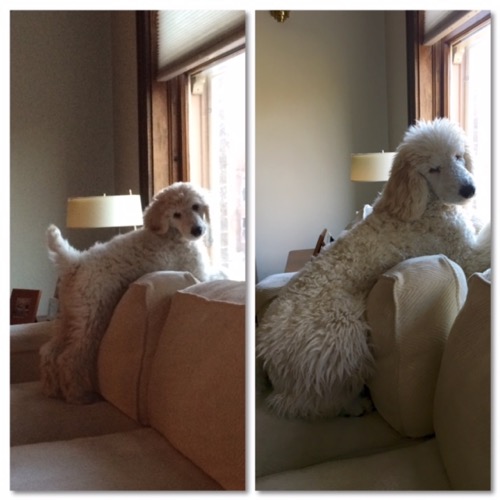
He still loves that spot on the couch (September):
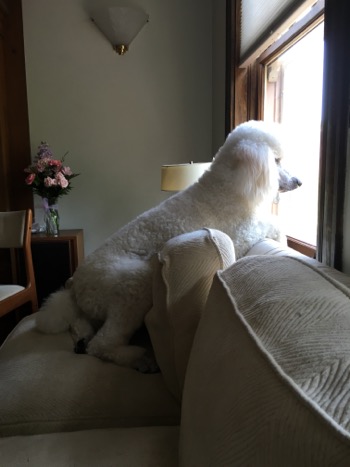
Demonstrating his prowess on his hind legs:
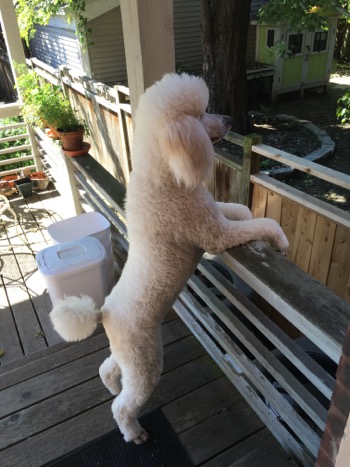
And here he is just a couple of weeks ago, victorious in his removal of the squeaker from a toy:

If you have a dog, please give him or her a treat in honor of Bix’s birthday!
Confessions of an email hoarder
I openly admit that I have been an email hoarder. I abandoned my emails on my old Windows computer when I switched to the Mac in 2008. And since then I had a tendency to hang on to all emails that might possibly come in handy some day.
I keep a clear email inbox but I do so by moving emails to an archive folder, rather than deleting them. That seemed to work well for me because I could simply search for emails I might need. But I was completely indiscriminate in terms of what I decided to archive. It was easier to archive than to make a decision to delete.
Despite a “less is more” attitude and my rejection of the “But I might need it some day” reason to keep physical stuff, I saw no disconnect with hanging on to digital items forever and ever. In my mind, space was plentiful, and using the Search function on my Mac I could find anything, so it wasn’t a problem.
And I was right: it wasn’t a problem. Until it was.
Last week my computer told me that 99 percent of my hard drive was full. My 500 GB hard drive had only 5 GB available. What? I took the computer’s suggestion to optimize my hard drive, which gained me another 25 GB, and I reached out to my Mac consultant, the wizard Gabriel Steinbach of The Mac Guys and we did a virtual consultation. We discovered that something was messed up in hard drive, probably as the result of my simply transferring everything (without decluttering) every time I bought a new computer. This is my third MacBook since 2008. I was hoping to get another year out of it.
The solution, we hope, is what Gabe calls a “clean reinstall” of the operating system. So he’s going to wipe the computer clean, reinstall the operating system and put the essentials back on the computer, along with my data.
That led to a discussion of what exactly is essential for my computer. And then we talked about my emails. Most modern computer users use IMAP email protocol which stores the emails on the server. I’ve used POP3 for decades and was more comfortable with storing them on my own hard drive. They feel more safe and secure there to me. But my using a POP3 server makes the process of transferring my email back onto my computer a huge hassle, rather than the breeze it would be if I used IMAP.
So I resolved to let go of unnecessary emails. And that was an interesting experience—it put me smack in my clients’ shoes. I heard myself saying things to Gabe that my clients with hoarding tendencies say to me about physical items. It was a bit of an existential crisis, since I am so committed to the benefits of living with less stuff.
I gave some really serious thought to why I like keeping all that email. I had almost 30,000 emails in my Archive folder alone and tens of thousands in other folders. I came to realize that the voluminous email archive allowed me to:
- Not have to make notes elsewhere
- Be the hero who can get my hands on information
- Recall any fact that came to me via email
- Keep track of purchases for tax purposes
- Keep track of client communication (Gabe suggested I shift to a CRM.)
- Let go of worry about forgetting things
So I shifted my perspective and thought about the worse that could happen if I couldn’t get my hands on a particular email. I realized that in most cases, it wouldn’t result in a problem. Temporary discomfort, perhaps. But not a long-lasting problem.
So here’s what I did:
- I searched my archive for correspondence from certain friends and family members and moved them into appropriately named folders.
- I kept all client correspondence
- I kept 2016 archived emails and receipts and trashed the rest.
- I deleted eight years’ worth of accumulated emails from various professional email lists I was on, since I realized I never looked back at them.
As the emails were deleted, I felt a little anxiety. And then a whole lot of relief.
I feel like I’ve pared the emails down to the bone. But in fact I still have just under 25,000 emails spilt among 65 folders. I’m sure I could let go of more, but that’s a reduction of at least 2/3—I bet I had more than 75,000 emails.
I’m hopeful this will be enough to make putting the emails back on my computer relatively easy. And then I’m hoping to let those reside there and shift to an IMAP system to avoid any future problems.
ScholarShop closing in 2017 but St. Louis has an alternative

If you live in St. Louis, you’re probably familiar with the venerable ScholarShop. It’s a resale store that sells clothing and accessories (and a few housewares), run by the Scholarship Foundation of St. Louis. The 57-year-old shop, with two locations, is a great place to donate clothing because it offers an itemized, valuated receipt at year’s end. It’s also a great place to shop. I’ve bought many, many items there over the years.
I was shocked to learn a couple of weeks ago that the Scholarship Foundation will be closing the ScholarShop in 2017. Apparently it has not been generating enough income to make it worthwhile for the Foundation to operate it. According to this article on the St. Louis Post-Dispatch’s website, they will accept donations through the end of 2016 and will probably remain open for shopping through mid-2017.
But I wanted to make sure my St. Louis readers are aware that there is an another worthy resale shop in St. Louis that also provides a valuated receipt. It’s The ReSale Shop, run by the National Council of Jewish Women-St. Louis Section. I also donate to, and shop at, this terrific shop. It’s located at 295 N. Lindbergh Blvd., between Highway 40/64 and Olive.
Like the Scholarship Foundation, the NCJW does good work that benefits the community with the money generated by the shop. They make it easy to donate and get a tax deduction. And the shopping experience is terrific. I encourage you to donate and shop there!
Time for a new Project 333 collection!
September 30 was the end my first Project 333 season. From July 3 to yesterday October 2, I chose from only 33 wardrobe items when getting dressed each day. In a nutshell, the 33-item collection included clothing, shoes, jewelry and accessories. It did not include underwear, sleepwear, loungewear, or exercise clothes. It also did not include dog-walking clothes. Please read my August 1 explanation of Project 333 for complete details.
Yesterday was the big day that I’d been looking forward to for a couple of weeks: I changed out my 33 items for another 33-item seasonal collection that will last me until the end of year.
I’ll tell you about that in a second, but first I have a surprise to report: I did not wear all 33 items! That’s right. At the end of the three months there were eight items I never wore (a dress, two jackets, three shirts, a belt and a down vest). And there were four more that I didn’t wear until September 30 (a poncho, a shirt, a pair of shoes and pants). So basically I dressed from 21 items the whole quarter.
A giant caveat is that when I lead team organizing jobs, I wear exercise clothes, which were not included in the 33 items. Clothes worn on one-on-one organizing appointments, or appointments to give estimates, were included.
The experience has been really positive. Project 333 makes getting dressed so fast. It makes laundry easy. It also makes packing easy. I love being able to find anything in my closet or drawers very easily. And I absolutely love having fewer options because it makes my life easier.
So yesterday, I changed out my clothes to the new collection. All the clothes I selected came from the “Favorites” bin I’d created when I was binning up the clothes in July. That tells me that there are two more bins of clothes I could probably donate without suffering!
It took a little effort to whittle it down to 33—at the first pass I had about 40 items. But I managed to do it. Here’s what’s in the collection:
- 5 pairs of pants (including two pairs of jeans and one pair of leggings)
- 2 turtleneck sweaters
- 4 other sweaters
- 2 ponchos
- 1 shawl
- 3 jackets/cardigans
- 1 dress
- 2 long-sleeved tops
- 2 short-sleeved tops
- 1 shell
- 1 pair of long boots
- 1 pair of ankle boots
- 1 pair of dress shoes
- 1 necklace
- 3 pairs of earrings
- 1 down vest
- 2 coats
Here’s a photo of the bulk of it:
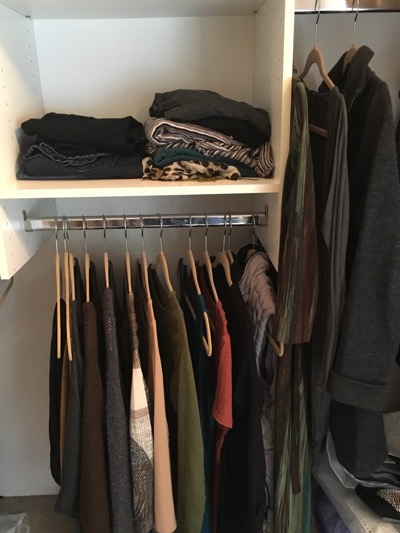
It’s worth noting that there was some overlap between the two seasonal collections: A down vest, two ponchos and a shawl, one pair of jeans, and three shirts appear in both collections, along with one pair of earrings, a necklace, and a scarf. That’s 11 items. A third of the collection.
I hate winter, but I prefer winter clothes to summer. So it was fun for me to pick out old friends to dress in. I foresee needing to purchase some very comfortable but nice flat shoes and perhaps a skirt. If I do that, I’ll try to take items out to compensate, so the collection doesn’t swell.
As much as I’m looking forward to getting into my leggings, I know that I will miss my white jeans. They were the foundation of my wardrobe this summer!
All in all, Project 333 has a been a real success for me. I’m interested in hearing from you if you’ve tried it!
Links
- Organize Your Family History
- Ravelry
- Are you interested in becoming a professional organizer?
- National Association of Productivity and Organizing Professionals
- NAPO St. Louis
- Getting to Good Enough podcast
- Shannon Wilkinson, life coach
- Peace of Mind Spending
- Institute for Challenging Disorganization


